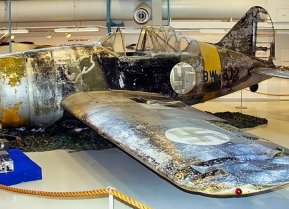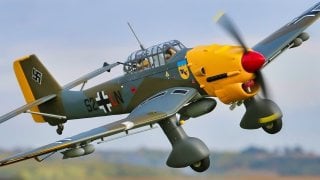Junkers Ju 87 Stuka Dive-Bomber: Nazi Germany's Most Terrifying World War II Plane
Few aircraft have ever caused as much terror – to both seasoned ground troops and helpless civilians alike – as the Luftwaffe's Junkers Ju 87 dive-bomber.
Few aircraft have ever caused as much terror – to both seasoned ground troops and helpless civilians alike – as the Luftwaffe's Junkers Ju 87 dive-bomber.
Widely known simply as the "Stuka," from the German word for dive bomber (" Sturzkampfflugzeug"), the Ju-87 was one of the first aircraft to be designed specifically with such tactics in mind. The dive-bomber earned its reputation as an aircraft to be feared in the Polish campaign, where it excelled at close support of ground troops.
Despite being outclassed even by the Battle of Britain, the Ju 87 fought on every front between 1939 and 1945. It was also adaptable and was employed in numerous other roles throughout the war. The Ju 87's fixed undercarriages provided sturdy platforms for takeoffs and landings, including on improvised airfields in the field, but at the cost of airspeed due to drag. However, it also featured some advanced features for the era, including a device to pull the aircraft out of a steep dive if the pilot blacked out and lost control.
Notable Ju 87 Facts
It was the first combat aircraft employed in the Second World War. When Germany began its invasion of Poland on September 1, 1939, the Luftwaffe had 366 Ju 87 ready for service, and three of those aircraft carried out the first bombing mission of the war, actually beginning an attack eleven minutes before the official German declaration of hostilities. The aim of this mission was to destroy the Polish demolition charges wired to the bridges over the Vistula River at Dirscha. However, the mission failed, and the Poles destroyed the bridge before the Germans could reach it.
While known for its attacks on ground troops, the Ju 87 Stuka also sank more ships than any other aircraft type in history. Much like the United States Navy's Douglas SBD, the Stuka was well-suited as an anti-shipping weapon, and Ju 87 pilots quickly learned to attack from astern, diving at a 45-degree angle and following the ship's evasive actions. Ju 87s were successfully employed against the Polish Navy, destroying nearly the entire fleet in port, and went on to cripple two Allied cruisers and sank multiple destroyers and sloops and during the invasion of Norway, and later harried vessels evacuating Allied troops at Dunkirk.
Later in the war, the Ju 87G "Gustav" was employed on the Eastern Front against Soviet armor. Powered by the Junkers Jumo 211 engine, and equipped with two specially modified Flak 18 37mm high-velocity, anti-aircraft guns, the aircraft proved effective at targeting the relatively thinly armored rear parts of Soviet tanks.
The Luftwaffe's Hans-Ulrich Rudel became Germany's most highly decorated combat pilot despite only shooting down nine enemy aircraft. However, he successfully destroyed some 500 Soviet tanks, the equivalent of more than three Red Army tank corps during the war.

While Germany never completed construction on its aircraft carrier, the Graf Zeppelin, a small batch of naval Ju 87s was built for use aboard. These Ju-87C models featured folding wings, and could carry a torpedo. The few completed aircraft operated from ground bases instead.
Despite the fact that some 6,000 Stuka dive bombers were produced, there are only two surviving intact aircraft in the world today. One is a ground-attack variant at the Royal Air Force Museum outside London, while the other is at the Chicago Museum of Science and Industry. A third aircraft is being restored to airworthy condition from two wrecks. It is owned by the late Paul Allen's Flying Heritage & Combat Armor Museum in Everett, Washington.
About the Author: Peter Suciu
Peter Suciu is a Michigan-based writer who has contributed to more than four dozen magazines, newspapers and websites. He regularly writes about military hardware, and is the author of several books on military headgear, including A Gallery of Military Headdress, which is available on Amazon.com. Peter is also a Contributing Writer for Forbes.
All images are Creative Commons.


